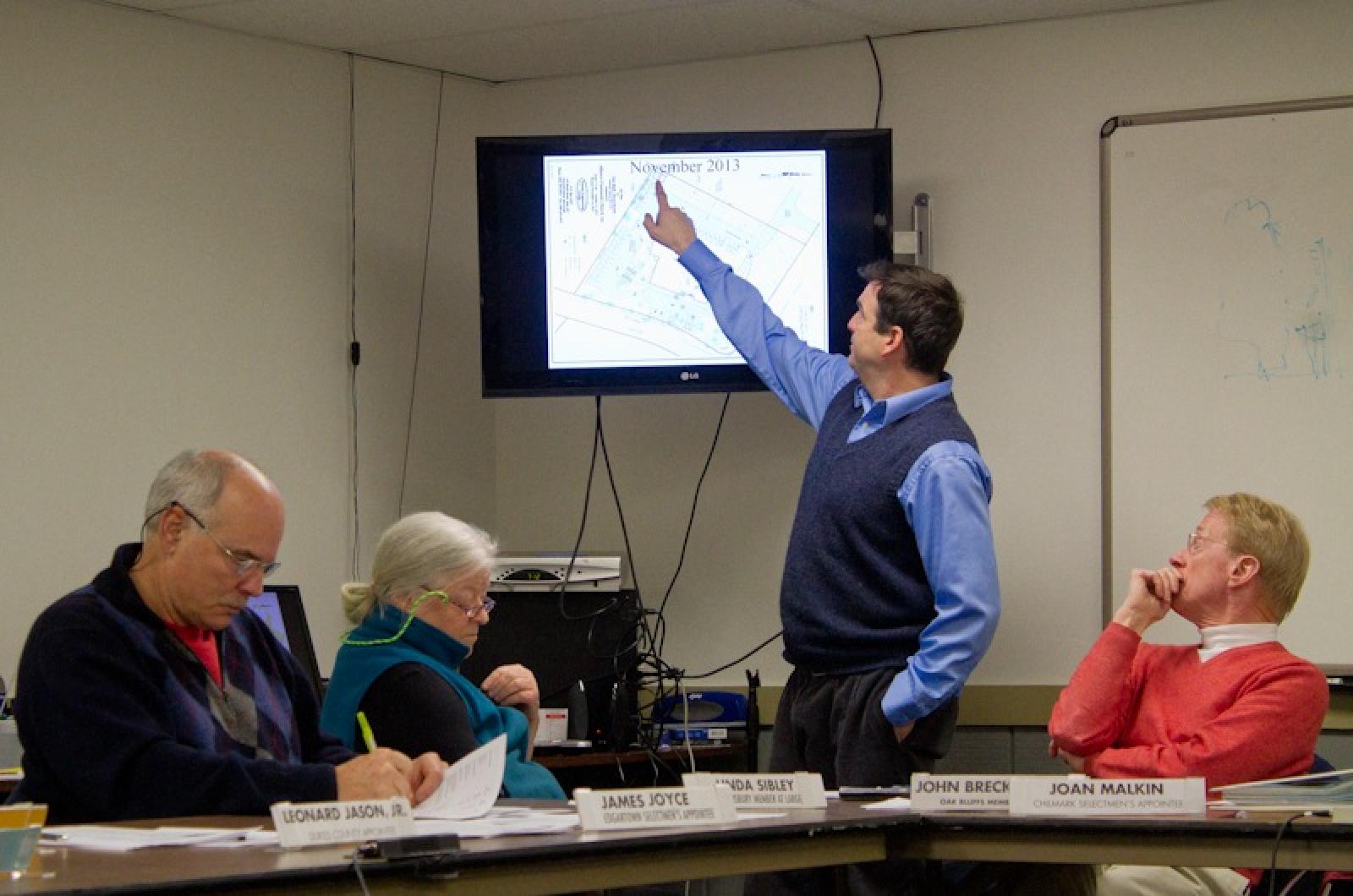A divided Martha’s Vineyard Commission turned down a long-scrutinized plan to expand an Oak Bluffs building into a church this week, citing visual impact, neighborhood concerns and future building use as primary concerns.
The final vote was 4-3 against the project following a three-hour discussion at the Olde Stone Building Thursday night. There were 13 commissioners present, but two abstained from the final vote and four excused themselves from discussion and voting at the outset.
Under review by the MVC as a development of regional impact (DRI), the project involves a building at 1 Ryan’s Way which is owned by Alliance Community Church (formerly Nova Vida). The current project is a modification to a DRI approved by the commission in 2008. Some landscaping was completed on that project but a 150-seat community church was never built. In 2012 the church applied for permission to put an addition on the building. That triggered a second DRI due to building size, intensity of use and amount of parking.
A public hearing opened in May and hearings continued throughout summer and fall, with the final session Thursday night.
The new project would add 4,500 square foot to the building footprint bringing the total to 12,430 square feet, and would include a 150-seat church sanctuary, a community room, commercial kitchen and three-bedroom parsonage apartment.
The congregation of Alliance Community Church was most recently listed as between 65 and 80, a decrease from the 85-90 it had in 2008.
Commissioners said they were largely satisfied with the applicant’s proposals to address wastewater management, manage the commercial kitchen and reduce the size of the basement area. But the planned community room was a sticking point as well as the size and scale of the building relative to the neighborhood.
The application says the community room is intended for church-related activities, but hours of use were not specified. That bothered some commissioners. Erik Hammarlund said in the absence of specified hours the room could be used between 7 a.m. and 9 p.m. He cautioned that the commission should not “assume the use of the community room is limited to this church right now,” and needed to think long-term.
“Another church can come in [later], another tenant could come in,” Mr. Hammarlund said.
Commissioner Linda Sibley acknowledged that a church needs space beyond the sanctuary to host activities, but said she was “really stuck on the fact that use of the community room is poorly defined.”
Other commissioners questioned whether the church needed an expansion when the congregation was smaller than it had once been.
“The people that are for this project haven’t convinced me that they need this size,” said commissioner Brian Smith. He added that while he was uncomfortable telling a church how large its building could be, the size of the project in a residential area was also troubling. During earlier public hearings Ryan’s Way residents registered strong concerns about the potential impact on the neighborhood.
Commissioner James Joyce said both the size and design of the structure were out of character for the area, leading to discussion about the look of Edgartown-Vineyard Haven Road in general.
Mrs. Sibley observed that while churches are traditionally located within walking distance of homes, the section of Edgartown-Vineyard Haven Road where Alliance Community building is has “zoned itself to become a strip of institutions and that’s not the same thing as the traditional church in a residential neighborhood.”
“I don’t think it’s beneficial to the community as a whole that we have this strip,” she said.
“And it looks like Everywhere, USA,” Mr. Smith added.
“There’s no place else on the Island that has this particular character, and it’s not solvable,” Mrs. Sibley said.
Commissioner Douglas Sederholm favored approving the plan although he said he was not in love with the bigger building.
“It doesn’t make me happy but I don’t think it’s an unreasonable use of the property as a church and that’s good enough for me,” he said. Mr. Sederholm noted the large number of conditions (10) that had been developed to be attached to possible approval of the plan. “I don’t know what more we could do to try to balance the interest of the neighbors and the interest of the applicants,” Mr. Sederholm said. He said he was “willing to accept the risk that the community room would be used a great deal.”
“It’s a church, that’s what churches do,” he said. “I don’t see we’ve limited it in any other house of worship.”
But Mr. Smith said that while the project had benefitted from a give-and-take between the MVC and the applicant, for him the detriments still outweighed the benefits. “There’s a lot of good things that came out of this modification,” he said. “I think we like a lot of things except for the bulk of the building.” He suggested that if the project was denied the applicant could rework the plan and come before the MVC again.
Mrs. Sibley agreed. “It is 90 per cent better than what it was, but there are still loopholes,” she said.
MVC voting procedure on DRIs allows three paths to a decision: a motion to approve, a motion to approve with conditions and a motion to deny.
On the Allliance project the motion was to approve with conditions. The roll call vote follows:
Voting yes were Christina Brown, Fred Hancock and Douglas Sederholm.
Voting no were John Breckenridge, Joshua Goldstein, James Joyce and Brian Smith.
Erik Hammarlund and Linda Sibley abstained.
Clarence A. Barnes 3rd, Madeline Fisher, Leonard Jason Jr., and Joan Malkin recused themselves and left the room during the discussion and vote.







Comments (5)
Comments
Comment policy »